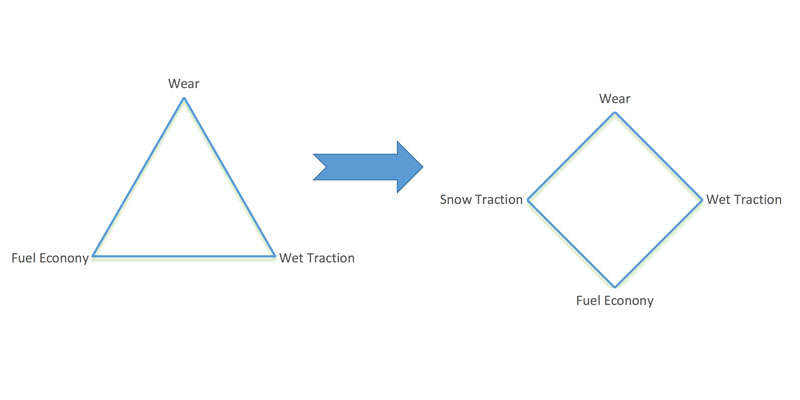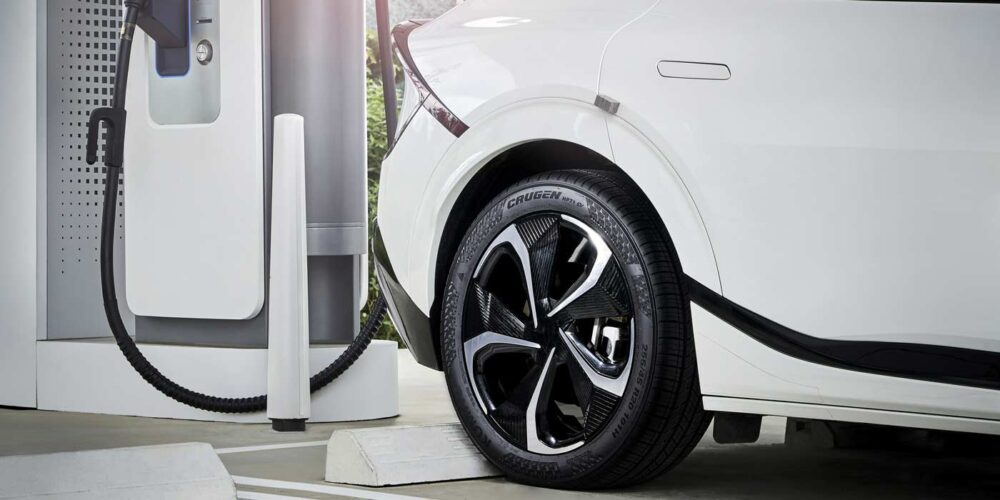I grew up in Michigan during the ’50s and ’60s. Although my parents did not like the winters, I loved playing in the snow outside under the bright Michigan sun. Driving on snow-covered roads with bias tires in the ’60s was a challenge, and most people I knew changed to winter tires, usually with studs for added ice traction. The introduction and proliferation of all-season radial tires has eliminated most of the need to change tires when the seasons change. While all-season radial tires have been available for more than 30 years, the materials and tire design continue to evolve and improve.

After graduating from college in Michigan with a degree in chemistry, I moved to Ohio to work with one of the large tire companies based in Akron. I was amazed at how many people were working to design tires and how complicated they seemed at first look. During the early ’70s, there were still a lot of bias tires being made, but the trend was clearly toward radial because of the longer tread life and better traction. Radial tires are more complicated than bias tires, have more internal components and use some different materials.
The company I worked for at the time was heavily involved with supplying tires to automobile companies, who were trying to switch to radial tires because of better fuel economy necessitated by the spike in gasoline prices from the Organization of the Petroleum Exporting Countries’ (OPEC) oil embargo. The tread compounds on radial tires were originally developed for bias tires at a time when fuel economy was not nearly so important. Throughout the ’80s, there was a relentless drive to reduce tire rolling resistance and improve fuel economy for OE applications. Most of this work focused on the tread compound because the tread causes more rolling resistance than any other part of the tire. New polymers, new types of carbon black and silica/silane were introduced to improve fuel economy and keep the traction required for stopping distance.
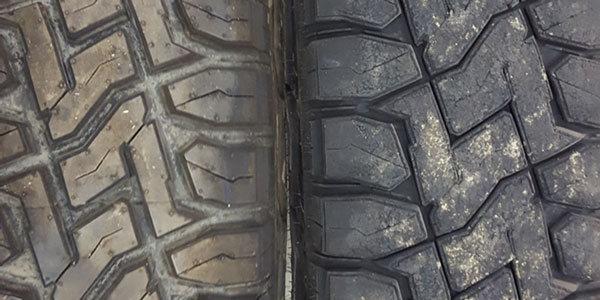
People soon noticed that tires with good traction and great fuel economy tended to wear out quickly. During the ’90s, tread wear started to be addressed. There was soon an escalation in treadwear warranties with each company trying to leapfrog the other. The tread compound was now required to have good wet traction, low rolling resistance and ever higher abrasion resistance. These three opposing requirements for tread compounds became known as the “magic triangle” and the objective was to make the triangle bigger to do everything even better. More recently, snow traction has been added to the list of criteria important for tread compounds in North America and the magic triangle became a “magic square.”
While all-season tires had been around a long time, ultra-high performance all-season (UHP A/S) tires were introduced in the 2000s. UHP A/S tires shifted the magic square slightly away from fuel economy toward wet traction. At the same time, tread wear warranties for these tires reached levels unheard of even for the best wearing tires from 30 years ago. Currently, there are UHP A/S tires on the market, but providing the necessary balance to achieve AA Traction (which identifies a true UHP tire) with a verified mileage warranty and acceptable performance for winter conditions requires tools which weren’t previously available to the industry. From a materials perspective, achieving a higher performance level in the “magic square” is a remarkable accomplishment. The compounding for winter conditions is stressed at temperatures below 40°F and add a significantly different variable to meet the needs of the driver.
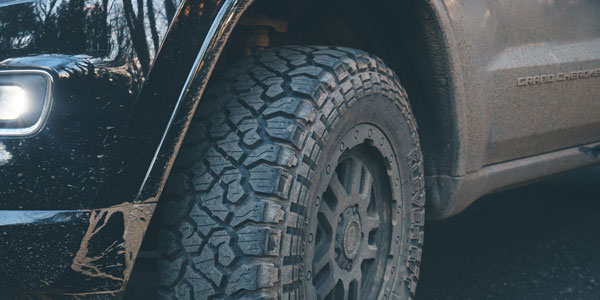
Design Compromises
The key to getting around tradeoffs in wear, traction, fuel economy and rolling resistance is to understand that each of these performance characteristics occur at different combinations of temperature, frequency and strain. Laboratory instruments and material modeling have improved over the years so that tire materials can be quickly evaluated for potential advantages. Materials can be dynamically tested through a wide range of temperature, strain and frequency. This information is used to predict wet, dry, snow traction, steering response and rolling resistance.
Recently, we’ve seen an increased demand for light truck products that achieve a balanced performance across the parameters described in the “magic square,” plus a need for improved chip and chunk resistance. This has created a new set of criteria that has challenged materials and compounding teams. For example, products targeting the growing rough or rugged terrain segment are offering many of the characteristics of traditional all-terrain tires, but added benefits previously only available in a traditional mud-terrain tire. The compounding required to achieve exceptional off-road performance with emphasis on chip and chunk is an outcome that wasn’t available until top tier companies were able to achieve the necessary balance requested by the market. This differentiation is usually noted by the retailer if they don’t verify the performance of products that may offer a similar aesthetic appearance but haven’t achieved this next level of compounding performance.
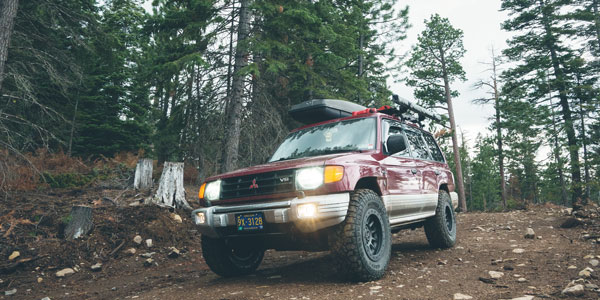
The Future of Tire Compounding
The emphasis now is toward sustainability, which includes recycling, using plant-based materials, making tires more fuel-efficient and also longer lasting. Recycling tire materials is much more challenging than melting and re-using plastics because rubber does not melt like plastic. Rubber can be ground to a fine powder and small amounts used in some parts of the tire. Rubber can also be pyrolyzed and the oils and carbon black recovered. However, recovered carbon black is not as reinforcing as original carbon black, so only small amounts can be used and only in a few parts of the tire.
Many plant-based natural rubber is used to make tires, but rubber trees grow in a narrow band of latitude around the globe and may be threatened by climate change in the long term. Many other plants produce a rubber latex. For example, the guayule bush that flourishes in the southwest U.S. has been commercially developed to provide an alternative to natural rubber. Dandelions are also being studied as a source of rubber.
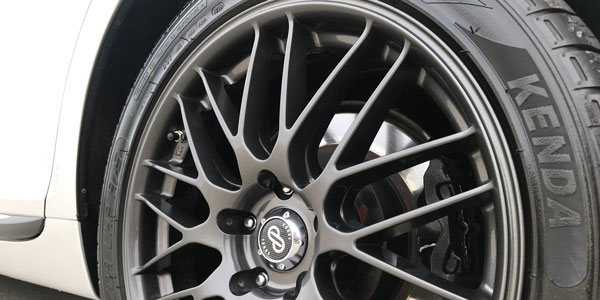
Currently, plant-based raw materials are being used to make monomers that can be polymerized into synthetic rubber. Manufacturers have found that plant-based resins in tread compounds improve wet traction without hurting fuel economy, and soybean oil improves snow traction without affecting tread wear. Some of the other chemicals used in rubber formulations are being made from plant-derived raw materials. As technology changes, chemists will continue to search for ways to improve sustainability.
Over the past 40 years, tire chemists have overcome many challenges, and I am confident they will continue to meet the needs of tire consumers while balancing industry demands.
Check out the rest of the December digital edition of Tire Review here.

